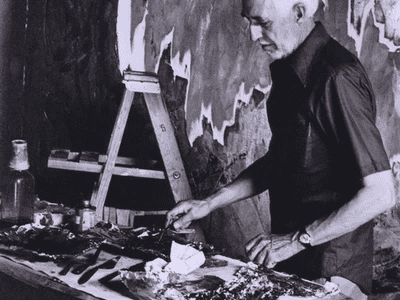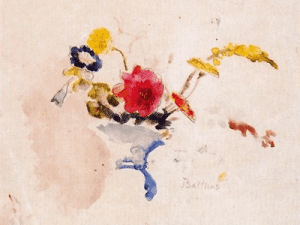(Skip to bullet points (best for students))

Born: 1904
Died: 1980
Summary of Clyfford Still
Clyfford Still was the first to break through to a new and radically abstract style devoid of clear subject matter, while not being as well-known as some of his New York School peers. His mature paintings make use of large expanses of colour to depict monumental-scale confrontations between man and nature. He once stated, “These are not paintings in the traditional sense; they are life and death merging in fearful union… they kindle a fire; through them I breathe again, hold a golden cord, find my own revelation.” Still influenced a second generation of Color Field painters as a believer in art’s moral importance in a befuddling modern environment.
Still’s overarching subject is the existential battle of the human spirit against the forces of nature, a conflict he expressed in his term “the vertical necessity of life.” It finds expression in the rebellious vertical shapes that run through the bulk of his works.
His enormous fields of colour have been compared as caves or immense abysses lit by crackling bursts of light at times.
Still’s transition to fully abstract painting in the mid-1940s foreshadowed and inspired his Abstract Expressionist peers’ transition to non-representational art.
Still was known for being a tough character who avoided the New York art community, fought most critiques of his work, and went to great efforts to control how his paintings were sold, collected, and shown.
Childhood
Clyfford Still was born in 1904 in Grandin, North Dakota, and spent his childhood in Spokane, Washington, and Alberta, Canada, where his family owned a wheat ranch in what was then the final bastion of the North American frontier. The wide, flat terrain and harsh lifestyle of the Canadian prairie would have a lasting impact on his worldview and creative practise, even if he later rejected it.
Early Life
In 1926, Still returned to Washington and enrolled at Spokane University after a brief stay at the Art Students League in New York. During the next decade, he studied art, literature, and philosophy, graduating from Spokane High School in 1933 and earning a Master of Fine Arts degree from Washington State College in 1935. For several years, he would continue to teach at Washington State.
Untitled(Indian Houses, Nespelem)(1936) is a sombre rural landscape reminiscent of American Regionalism, while Untitled(1935) is a more Surrealist-inspired piece in which the human figure is reduced to nearly entirely abstract shapes. However, the underlying subject of all of these works appears to be man’s struggle to live in a harsh environment, a concept that is sometimes depicted by vertical forms rising in defiance against a horizontal terrain.
The colour scheme (dark, earthy tones interrupted by flashes of brilliant colours) and technique (thick layers of paint applied with a palette knife) that would come to dominate the artist’s whole output emerge at this time.
Mid Life
In the early 1940s, Still moved many times, first to California (where he met Mark Rothko), then to Virginia (where he taught at the Richmond Professional Institute), and eventually to New York in 1945. This was the start of a very successful era for him, as demonstrated by the works he exhibited in 1946 at Peggy Guggenheim’s Art of This Century Gallery, which displayed a distinctive and innovative style on the verge of maturity. All recognisable human forms have been replaced with flame-like formations that soar vertically across dark and vast landscapes in these monumentally sized paintings.
Still began to shy away from using referential names for his pieces as he adopted a non-representational approach, and finally settled on a nomenclature made completely of numbers and dates. 1944 -N No.2 is representative of his style and titles during this time period.
Still’s works from this era represent a highly unique breakthrough into abstraction in American painting, and they would have a significant influence on the New York painters who would eventually become the leading exponents of Abstract Expressionism. Despite his friendship with these artists, Still resented the idea of being associated with any school or movement, and he remained a self-described outsider. Still spent a lot of time on the West Coast during these years, despite his involvement in New York. In 1947, he began an outstanding teaching career at the California School of Fine Arts, where he composed much of his work.
Still returned to New York in 1950 and remained there for the following ten years. He refined his motifs and added new components to his work as he continued to explore and build on his distinctive themes. In particular, he began to use sections of bare canvas in his works and began to concentrate on more horizontal compositions. Still, a famously cantankerous figure, became more disillusioned with the New York art world.
He disagreed with the majority of his contemporaries, ending lengthy friendships with Rothko, Pollock, and Newman, as well as severing connections with his galleries. He even turned down an opportunity to show his art at the Venice Biennale in the American Pavilion in 1957. Around the same time, Still began imposing tight rules on how institutions may lend and show his works. In several cases, he even refused to allow other artists’ work to be shown alongside his.
Late Life
Still moved to a farm near Westminster, Maryland, in 1961. He continued to create paintings until his death in 1980, but he never returned to the New York art world, which he considered hopelessly frivolous and decadent. Instead, he worked in solitude, displaying his paintings only when he had total control over the exhibition’s settings.
Because of the limits Still placed on the collecting and presentation of his paintings, the majority of his work went unnoticed until 2011, when the city of Denver was able to construct a museum dedicated to Still. Appraisals of his work in the past have tended to centre on a discussion of his challenging personality as much as they have on a critique of his life’s work. However, given the sway Still had upon his New York School colleagues, it’s evident that his works were pivotal in the development of Abstract Expressionism.
Famous Art by Clyfford Still
Untitled(Indian Houses, Nespelem)
1936

Untitled (Indian Houses, Nespelem) is typical of the artist’s late 1920s to mid-1930s oeuvre. It was carried out at the town of Nespelem, which is located on the Coleville Indian Reservation, where Still co-founded an artist’s colony in 1937. Still synthesises the ideas of Gustave Courbet, Paul Cézanne, and American Regionalism in this piece, while simultaneously developing his own creative philosophy and style.
1948-C
1948

1948-C is an excellent example of Still’s mature style as it appeared in the mid to late 1940s: figuration has vanished completely, leaving just a weird, crackling field of colour. The work contains dramatic connections between compositional elements such as foreground and background, light and dark, which the artist describes as “life and death merging in fearful union.” It’s also typical of Still’s late 1940s work in that it’s dominated by hues from the extreme end of the spectrum – in this case, bright yellows.
1957-D-No. 1
1957

In the mid-1950s, Still began to move toward more vertically oriented canvases, as shown in 1957-D-No. 1. The brief bursts of colour that punctuated prior paintings’ gloomy expanses have been transformed into monumentally sized vertical shapes that rise and fall over an almost mural-like composition in this piece. Still was drawn to compositions that express “enclosure and liberation, containment and precarious release;” according to art historian David Anfam; here, the dramatic tension of yellow and black evokes exactly that difference.
BULLET POINTED (SUMMARISED)
Best for Students and a Huge Time Saver
- Clyfford Still was the first to break through to a new and radically abstract style devoid of clear subject matter, while not being as well-known as some of his New York School peers.
- His mature paintings make use of large expanses of colour to depict monumental-scale confrontations between man and nature.
- He once stated, “These are not paintings in the traditional sense; they are life and death merging in fearful union… they kindle a fire; through them I breathe again, hold a golden cord, find my own revelation.”
- Still influenced a second generation of Color Field painters as a believer in art’s moral importance in a befuddling modern environment.
- Still’s overarching subject is the existential battle of the human spirit against the forces of nature, a conflict he expressed in his term “the vertical necessity of life.”
- It finds expression in the rebellious vertical shapes that run through the bulk of his works.
- His enormous fields of colour have been compared as caves or immense abysses lit by crackling bursts of light at times.
- Still’s transition to fully abstract painting in the mid-1940s foreshadowed and inspired his Abstract Expressionist peers’ transition to non-representational art.
- Still was known for being a tough character who avoided the New York art community, fought most critiques of his work, and went to great efforts to control how his paintings were sold, collected, and shown.
Information Citations
En.wikipedia.org, https://en.wikipedia.org/.
Recommend0 recommendationsPublished in Artists





Responses